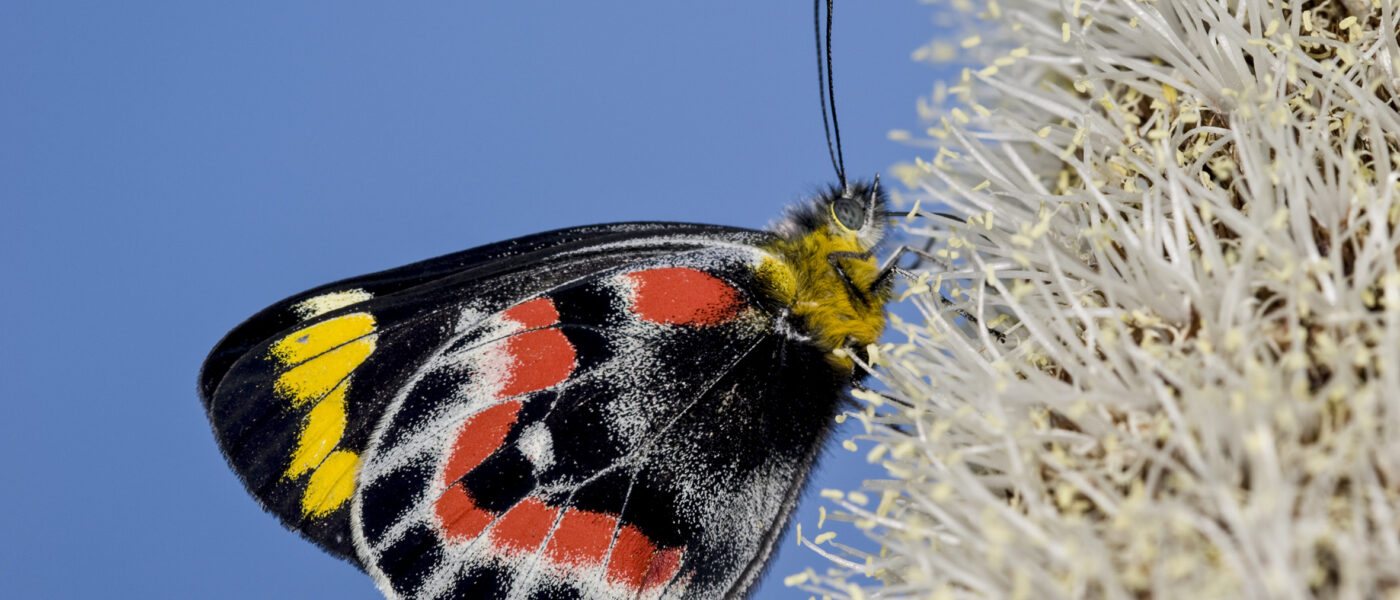Bushfires can devastate some insect populations
By Denis Crawford
Conventional wisdom tells us that the bush will recover after fire, and that the wildlife will return. It’s not that simple.
I’m not likely to forget February 13th 2024. It was the day a bushfire descended on my local town of Pomonal, destroyed 45 homes, many sheds and other structures, kilometres of fencing, and over 2700 hectares of bushland and private land. Luckily, our house survived but everything else was burnt, including the fruit and vegetable garden which has inspired many Pest Files. The house now sits in the middle of a blackened block.
Bushfires in the Australian landscape are a natural phenomenon. Birdlife Australia says, “Bushfires serve an important role in ecosystems where native plants and animals benefit from, and sometimes rely on, periodic burns of limited size and intensity.” But they go on to say, “human-induced climate change has increased the incidence of extreme fire weather and lengthened bushfire seasons, meaning fires are now becoming larger, occurring more often, and reoccurring in areas where vegetation has not recovered from previous bushfires”.
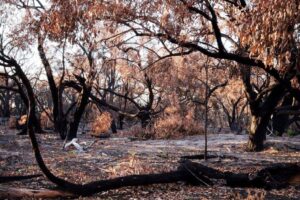
The property where I live also burnt out in 2006. We bought this property just after that fire, so we have already witnessed how the bush recovers from fire. Some plants such as grasstrees and eucalypts recover quite quickly, but other plants don’t. An example of the latter are the mistletoes which grow here – box mistletoe (Amyema miquelii) and wire-leaf mistletoe (Amyema preissii).
Mistletoes are not fire tolerant, so when a bushfire burns through an area all the mistletoes in that area usually die. Reestablishment of mistletoes is a slow process. First the mistletoe bird (Dicaeum hirundinaceum) brings in seed from an unburnt area, then the mistletoe seed has to germinate and grow. On our property it took about a decade for mistletoes of significant size to be noticeable up in the canopy. Those mistletoes have burnt in this recent fire. It’s hard to say if and when they may return because recent research (Kirk, 2022) suggests that mistletoes ‘may require a multi-decadal fire-free period to recover’.
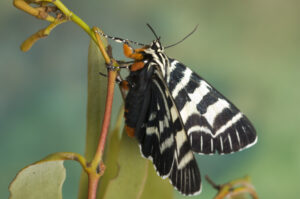
This is important because of the animals that are either supported by, or are reliant upon, mistletoes. Mistletoes are an important food source for birds, especially honeyeaters, and mammals such as possums. The larvae of some insects feed exclusively on mistletoe leaves. This includes the aptly named mistletoe moth (Comocrus behri), a beautiful black and white day-flying moth. Mistletoes are also the larval foodplants of several butterflies, particularly various ‘jezebels’ of the genus Delias (family Pieridae) and the spectacular ‘azure’ butterflies of the genus Ogyris(family Lycaenidae).
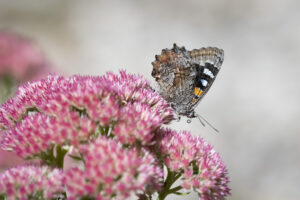
Pictured here is a female satin azure (Ogyris amaryllis). She is feeding on the nectar from a potted sedum – one of the few flowering plants left unburnt by the bushfire. She looks pretty drab here. It’s only when she opens her wings that you can see that she is an ‘azure’. The upper surface of her wings is a spectacular iridescent blue. These butterflies have a rapid and dancing flight and when in full sun the flashing blue announces their presence. I read a description which described it as ‘glistening blue tinsel-paper’, visible up to 50 metres away.
I wonder what her fate will be. The nearest unburnt mistletoe for her to potentially lay eggs on is about one kilometre away! If our female does manage to lay fertile eggs, what will happen after that is amazing. Larvae that hatch from the eggs initially feed on the mistletoe leaves during the day, but once the larvae reach their 3rd instar (moult) they feed at night and hide during the day. Ogyrislarvae are usually attended by small ants. These ants protect the larvae from predators in return for a feed of a fluid, containing a mixture of sugars and amino acids, that the larvae excrete from glands on their back.
Given the state of our block and the other properties and bushland that surrounds us, it is unlikely that we will see the return of resident populations of the insects mentioned here for some time. No mistletoe means no mistletoe moths, no jezebels and no azures. It used to be thought that mistletoes were pests and that it’s a good thing when bushfire kills the mistletoe in a woodland canopy. Research (Watson and Herring 2012) shows what happens when mistletoes are removed from the woodland canopy.
In a landmark experiment the authors removed mistletoes from woodland blocks in southeastern New South Wales. “Three years after mistletoe removal, treatment woodlands lost, on average, 20.9% of their total species richness, 26.5 % of woodland-dependent bird species and 34.8% of their woodland-dependent residents, compared with moderate increases in control sites and no significant changes in mistletoe-free sites”. The paper confirms mistletoe as a keystone resource.
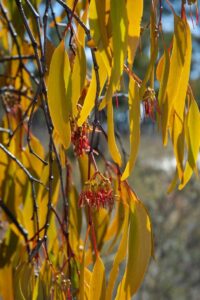
Professor Watson recently led a team in an experiment of a different kind – returning mistletoes to urban trees (Watson et al 2023). The team had good reasons to attempt this. Professor Watson says “Mistletoes provide many benefits for local biodiversity. Their flowers provide reliable nectar that encourages pollinators to linger longer. They then boost the populations of other plant species they visit. The nutrients in mistletoe leaves boost soil health and dramatically increase insect numbers when they fall to the forest floor.
In 2017 the team inoculated 28 London plane trees (Platanus × acerfolia) in inner Melbourne with creeping mistletoe (Muellerina eucalyptoides). The Professor says “Time will tell how the addition of these plants to the urban forest will affect Melbourne wildlife. Already, gorgeous imperial jezebel butterflies (Delias harpalyce) have been spotted emerging from creeping mistletoes in Princes Park.”
References:
Kirk, C.W. (2022) Survival and Recolonisation of Australian Mistletoes after High Severity Fire: Implications for the Warrumbungle National Park. University of Wollongong.
Watson, D. et al. (2023). Returning mistletoe to an urban forest: a restoration success story. Botany, doi:10.1139/cjb-2023-0069
Watson, D.M. and Herring, M. (2012) Mistletoe as a keystone resource: an experimental test. Proc. R. Soc. B 279, 3853–3860

